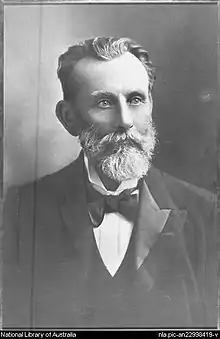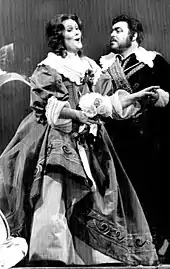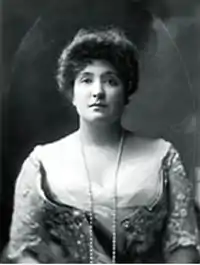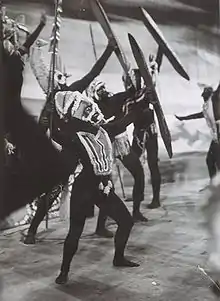Australian classical music
The earliest western musical influences in Australia can be traced to two distinct sources: in the first settlements, the large body of convicts, soldiers and sailors who brought the traditional folk music of England, Wales, Scotland and Ireland;[1] and the first free settlers, some of whom had been exposed to the European classical music tradition in their upbringing. An example of original music by a convict would be an 1861 tune dedicated to settler James Gordon by fiddler constable Alexander Laing.[2][3] Very little music has survived from this early period, although there are samples of music originating from Sydney and Hobart that date back to the early 19th century.[4] Musical publications from this period preserved in Australian libraries include works by Charles Edward Horsley, William Stanley, Isaac Nathan, Charles Sandys Packer, Frederick Augustus Packer, Carl Linger, Francis Hartwell Henslowe, Frederick Ellard, Raimund Pechotsch and Julius Siede.

History

Isaac Nathan's 1847 Don John of Austria was the first opera to be written, composed and produced in Australia. The establishment of choral societies (c. 1850) and symphony orchestras (c. 1890) led to increased compositional activity, although most Australian classical composers of this period worked entirely within European models and many undertook their training in composition in Europe or the United Kingdom. One of the earliest known composers was George Tolhurst, whose oratorio Ruth was the first composed in the then colony of Victoria in 1864. Some works leading up to the first part of the 20th century were heavily influenced by folk music (Percy Grainger's "English Country Gardens" of 1908 being a good example of this).[4] An estimated 10,000 Australians and New Zealanders traveled to Britain each year from the late 1880s to the early 20th century, and the number doubled between the World Wars. A majority was likely female, often a musician; in 1907 one commentator said that Australia's principal exports to Britain were "frozen sheep and pretty-voiced girls". Success in London was often seen as a prerequisite for fame in Australia for singers such as Nellie Melba, Amy Sherwin, and Ada Crossley.[5]
Australian composers who published classical music during the late nineteenth century include Hugo Alpen, Hooper Brewster-Jones, Thomas Bulch, Alice Charbonnet-Kellermann, George H. Clutsam, Herbert De Pinna, John Albert Delany Guglielmo Enrico Lardelli, Louis Lavater, George Marshall-Hall, Stephen Moreno, George William Torrance, Cesare Cutolo, Christian Helleman and Augustus Juncker.
Even for composers, a trip abroad could make a career:[6] George Frederick Boyle, who was born in New South Wales in 1886, had a great career in Australia as a piano prodigy but did not meet with international success as a composer until he traveled to Europe and the United States.[7]
From the time of Australia's Federation in 1901, a growing sense of national identity[8] began to emerge in the arts, although a patriotic attachment with the "mother country"[9] or "Home",[5] that is Britain, and the Empire, continued to dominate musical taste. European musical training became more available in Australia through migrants like Alice Charbonnet-Kellermann, Fred Werner and as an academic pursuit under emerging conservatory academics like Ernest Truman and George Marshall-Hall. In the war and post-war eras, as the Australian national identity continued to build, composers looked to their surroundings for inspiration. John Antill in his ballet Corroboree, Peter Sculthorpe and others began to incorporate elements of Aboriginal music, Richard Meale drew influence from south-east Asia (notably using the harmonic properties of the Balinese gamelan), while Nigel Butterley combined his penchant for International modernism with an own individual voice.[4]
By the beginning of the 1960s other strong influences emerged in Australian classical music, with composers incorporating disparate elements into their work, ranging from Aboriginal and south-east Asian music and instruments, American jazz and blues, to the belated discovery of European atonality and the avant-garde. Composers like Don Banks, Don Kay, Malcolm Williamson and Colin Brumby epitomise this period.[4] Others who adhered to more traditional idioms include Arthur Benjamin, George Dreyfus, Peggy Glanville-Hicks and Robert Hughes. In recent times composers including Julian Cochran, Barry Conyngham, Brett Dean, Ross Edwards, Gordon Hamilton, Matthew Hindson, Elena Kats-Chernin, Graeme Koehne, Constantine Koukias, Stephen Leek, Georges Lentz, Liza Lim, Richard Mills, Carl Vine, Martin Wesley-Smith, Nigel Westlake, and David Worrall have embodied the pinnacle of established Australian composers.
James Murdoch played a large part in promoting Australian music both at home and internationally, and in bringing Peggy Glanville-Hicks and Richard Meale back from self-imposed artistic exile overseas.

Performers

Well-known Australian classical performers of the past and the present day include:
- conductors Joseph Post, Sir Bernard Heinze, Sir Charles Mackerras, Richard Bonynge, Patrick Thomas, Stuart Challender, Simone Young, Geoffrey Simon, Benjamin Northey and Richard Gill;
- sopranos Dame Nellie Melba, Dame Joan Sutherland, Dame Joan Hammond, Marie Collier, Florence Austral, Marjorie Lawrence, June Bronhill, Joan Carden, Lauris Elms, Yvonne Kenny, Lisa Gasteen, Sara Macliver, Cheryl Barker, Deborah Riedel and Emma Matthews;
- mezzo-sopranos Yvonne Minton and Margreta Elkins
- tenors Donald Smith, David Hobson, and Rosario La Spina;
- baritones John Brownlee,[10] John Pringle, Robert Allman, Jeffrey Black, Peter Coleman-Wright, New Zealander Teddy Tahu Rhodes;
- bass-baritones Peter Dawson and Donald Shanks;
- bass Malcolm McEachern;
- pianists Percy Grainger, Eileen Joyce, Noel Mewton-Wood, Nancy Weir, Geoffrey Parsons, Piers Lane, Leslie Howard, Ian Munro, Gerard Willems, Kathryn Selby, Simon Tedeschi, Lisa Moore, Geoffrey Tozer, Roger Woodward, Rhondda Gillespie, Stephanie McCallum and Michael Kieran Harvey;
- harpsichordists and fortepianists Geoffrey Lancaster and Paul Dyer;[11]
- harpsichordist and multi-instrumentalist Winsome Evans;
- organist, fortepianist and harpsichordist Neal Peres Da Costa;
- violinists Elizabeth Wallfisch, Richard Tognetti and Dene Olding;Barbara Jane Gilby
- organist Christopher Wrench;
- cellists David Pereira;
- harpists Marshall McGuire and Alice Giles;[12]
- guitarists John Williams, Slava Grigoryan, Karin Schaupp;
- horn players Barry Tuckwell and Lin Jiang;
- oboists Diana Doherty;
- flautist John Lemmone, Jane Rutter;
- clarinetist Paul Dean;
- didgeridoo player William Barton;
- percussionists Claire Edwardes;[13] and
- oud player Joseph Tawadros.
Orchestras
State-based symphony orchestras, originally managed under the Australian Broadcasting Corporation (ABC) but now operating as separate independent bodies, have played a major role in performing mainstream orchestral repertoire for the general public as well as commissioning new works from Australian composers and ensuring that works by contemporary international composers are introduced to their audiences. These include the Sydney Symphony Orchestra, the Melbourne Symphony Orchestra, the Queensland Symphony Orchestra, the Adelaide Symphony Orchestra, the West Australian Symphony Orchestra and the Tasmanian Symphony Orchestra. There are also professional orchestras whose role is related specifically to opera and ballet performance, chiefly the Australian Opera and Ballet Orchestra based at the Sydney Opera House and Orchestra Victoria based in Melbourne.
There are several chamber orchestras which focus on works for smaller ensembles. These include the Australian Chamber Orchestra which tours regularly throughout Australia and has been well-received overseas,[14] the Melbourne Chamber Orchestra,[15] the Adelaide Chamber Orchestra[16] and the Camerata of St. John's.[17] Orchestral ensembles which concentrate on historically informed performance include the Australian Brandenburg Orchestra,[18] Van Dieman's Band,[19] and the Orchestra of the Antipodes.[20]
Leading chamber ensembles include the Australian String Quartet, the Goldner String Quartet, the Australia Ensemble,[21] Synergy Percussion,[22] Dean Emerson,[23] TRIOZ,[24] the Sydney Soloists,[25] the Southern Cross Soloists,[26] Guitar Trek,[27] Collusion (chamber ensemble),[28] the Elandra String Quartet, the Zephyr Quartet,[29] and the Tinalley String Quartet.[30] Chamber ensembles involved in historically informed performance include Marais Project,[31] Accademia Arcadia,[32] La Compania,[33] Ironwood,[34] and probably Australia's oldest group of this kind, The Renaissance Players.[35]
Musica Viva Australia, now the largest entrepreneur of chamber music in the world,[36] was founded in 1945 and has provided a major stimulus for public interest in chamber music by organising annual subscription programs of concerts by leading international and Australian ensembles.[37] Further interest has been stimulated by events such as the Australian Festival of Chamber Music[38] which was founded in 1991 and is held each year in Townsville, the Melbourne International Chamber Music Competition and the Asia-Pacific Chamber Music Competition, both of which are organised by Chamber Music Australia[39] and held every four years in Melbourne.
Several Australian composers have written chamber works. Among the older composers, Peter Sculthorpe stands out because he has written 17 string quartets up to 2010,[40] with performances in Australia and overseas and recordings by leading groups such as the Kronos Quartet. In the next generation, Brett Dean, himself a violist of note and a composer who has received world-wide recognition, has written several works for various ensembles including a string quartet called "Eclipse" which was commissioned by the Cologne Philharmonie[41] for the Auryn Quartet,[42] a string quintet entitled "Epitaphs" premiered in 2010 at the Cheltenham Music Festival,[43] the Santa Fe Chamber Music Festival,[44] La Jolla SummerFest[45] and the Cologne Philharmonie, and a sonata for violin and piano commissioned by Midori[46] for performance in 2010 in Stockholm and the Wigmore Hall,[47] London. Dean's near-contemporary, Julian Yu[48] has written over 30 works for various chamber ensembles including conventional trios and quartets, as well as unusual combinations such as a quintet for four percussions and piano, a septet for flute, percussion, harp, violin, viola, cello and double bass entitled "Pentatonicophilia", and an unconventional reworking[49] of Mussorgsky's Pictures at an Exhibition for 16 instruments.
Other piano and chamber works of special merit include Peggy Glanville-Hicks' Concertino da camera for flute, clarinet, bassoon and piano, Richard Meale's "Las Alboradas" for flute, violin, horn, and piano, Riccardo Formosa's "Vertigo" for flute (piccolo), oboe, clarinet and piano, Nigel Westlake's "Refractions at Summer Cloud Bay" for flute, bass flute, clarinet, soprano saxophone, violin, cello and piano, the piano works of Julian Cochran, Ross Edwards' "Laikan" for flute, clarinet, percussion, piano, violin and cello, Carl Vine's String Quartets Nos. 2, 3, 4 and 5, his Elegy for flute, cello, trombone, piano four-hands, organ and percussion, and "Inner World" for amplified cello and tape.[50]
Venues
The Sydney Opera House and Melbourne's State Theatre are the premiere venues for operas and concerts, and Opera Australia performs regularly there. Other venues for classical music, opera and ballet are the Queensland Performing Arts Centre in Brisbane, the Adelaide Festival Centre, the Canberra Theatre Centre.
City Recital Hall in Sydney, Hamer Hall, Melbourne, Melbourne Recital Centre, Perth Concert Hall, and Darwin Entertainment Centre are dedicated concert halls. Additionally, many regional centres have entertainment and performance venues which are used by state and national touring companies and individual performers, groups, and orchestras.[51]

Broadcasts
Music broadcasting has played an important role in providing classical music and jazz to the Australian public. Prior to the introduction of FM into the country, the ABC produced classical music programs which were broadcast through their local stations. Professor Alfred Ernest Floyd's program "Music Lover's Hour" was heard for over 25 years, beginning first on the local Melbourne ABC station in 1944 before being broadcast nationally.[52] Pianist and academic Lindley Evans[53] broadcast a series of programs called "Adventures in Music" on the ABC, but was probably better known and more influential through his appearances each Thursday under the pseudonym "Mr Music" on the ABC's national "Argonauts Club" program. Ralph Collins, formerly a record librarian at the ABC with an acute knowledge of music, hosted his own national music program for over 30 years from the early 1960s, and he was eventually nicknamed "Mr Sunday Morning" by the general public. John Cargher, a record retailer, avid collector of records and author of many books, presented two programs. The most popular was "Singers of Renown", which began on the local Melbourne ABC station in 1966 and was transferred by public demand to Radio National at the end of only 10 weeks and remained on air for 42 years. The other program, "Music for Pleasure", began on Radio National in 1967 and continued until 1996.
The national FM music network ABC Classic FM[54] was established in 1976 to broadcast classical music, jazz, operas, recitals and live concerts from Australia and overseas, music analysis programs and news about music activities. Its audience is now estimated as being about one million people,[55] not taking into account a growing number of international users who access its programs via its online service.[56] At about the same time, community not-for-profit FM stations were set up to enable volunteers to produce and present classical music and jazz programs. These included 2MBS FM[57] in Sydney, 3MBS FM[58] in Melbourne and 4MBS Classic FM[59] in Brisbane. More recently a similar station, 5MBS. has been established in Adelaide.
There are five important classical record labels in Australia: ABC Classics[60] Move Records,[61] Tall Poppies Records,[62] Melba Recordings,[63] and Master Performers.[64]
See also
References
- For more information, see Warren Fahey's essay "Australia and Its Traditional Music" Archived 2013-02-12 at the Wayback Machine
- "Alexander Laing". 24 March 2017.
- "Australharmony - Biographical register L (La-Lev)".
- Oxford, A Dictionary of Australian Music, Edited by Warren Bebbington, Copyright 1998
- Woollaeott, Angela (2001). To Try Her Fortune in London: Australian Women, Colonialism, and Modernity. Oxford University Press. pp. 4–7. ISBN 0-19-514268-3.
- "What of Australian Composers?". The Sydney Morning Herald. No. 31, 718. New South Wales, Australia. 28 August 1939. p. 7 (Women's Supplement). Retrieved 9 December 2018 – via National Library of Australia.
- "Baltimore Composers Walking Tour". Baltimore Composers Walking Tour.
- Elder, Catriona (2007). Being Australian: Narratives of National Identity. Allen & Unwin. ISBN 9781741149289.
- Elder 2007, p. 11: "... a country Australia was obliged to help and which in turn would help Australia.
- Brownlee, John Donald Mackenzie (1900–1969) Biographical Entry – Australian Dictionary of Biography Online. Adbonline.anu.edu.au. Retrieved on 2011-04-14.
- University of Sydney – Paul Dyer. Alumni.sydney.edu.au (2009-11-09). Retrieved on 2011-04-14.
- Representation for Alice Giles Archived 2012-03-08 at the Wayback Machine. Metronome Inc.. Retrieved on 2011-04-14.
- Claire Edwardes Percussion. Claireedwardes.com. Retrieved on 2011-04-14.
- Reviews. ACO. Retrieved on 2011-04-14.
- Experience orchestral music like never before. MCO. Retrieved on 2011-04-14.
- Home. ACO. Retrieved on 2011-04-14.
- Camerata of St John's > Home Archived 2013-08-08 at the Wayback Machine. Camerata.net.au. Retrieved on 2011-04-14.
- Australian Brandenburg Orchestra | HOME. Brandenburg.com.au. Retrieved on 2011-04-14.
- Van Dieman's Band Retrieved 5 January 2021/
- Orchestra of the Antipodes (Original Instruments Ensemble) – Short History. Bach-cantatas.com (2010-09-06). Retrieved on 2011-04-14.
- University of New South Wales – Australia Ensemble Archived 2014-10-13 at the Wayback Machine. Ae.unsw.edu.au (2010-10-26). Retrieved on 2011-04-14.
- Profile Archived 2015-06-29 at the Wayback Machine. Synergy Percussion. Retrieved on 2011-04-14.
- Home Archived 2012-09-04 at archive.today. Musica Viva. Retrieved on 2011-04-14.
- Selby and Friends – Welcome. Trioz.com.au (2011-03-22). Retrieved on 2011-04-14.
- Home Archived 2015-06-10 at the Wayback Machine. Musica Viva. Retrieved on 2011-04-14.
- Home Archived 2012-09-07 at archive.today. Musica Viva. Retrieved on 2011-04-14.
- Home Archived 2015-06-10 at the Wayback Machine. Musica Viva. Retrieved on 2011-04-14.
- The Chamber Music Series. Collusion.com.au. Retrieved on 2011-04-14.
- Home. Zephyrquartet.com (2011-04-07). Retrieved on 2011-04-14.
- Tinalley String Quartet Archived 2011-07-19 at the Wayback Machine. Melba Recordings. Retrieved on 2011-04-14.
- The Marais Project. The Marais Project. Retrieved on 2011-04-14.
- Home Archived 2012-09-05 at archive.today. Musica Viva. Retrieved on 2011-04-14.
- Home Archived 2012-09-03 at archive.today. Musica Viva. Retrieved on 2011-04-14.
- Ironwood Chamber Ensemble. Ironwood Chamber Ensemble. Retrieved on 2011-04-14.
- "The Renaissance Players Online Information Service". Archived from the original on 2009-06-09. Retrieved 2015-08-02.
- According to their 2009 annual report, Musica Viva Australia organised 2,221 music events
- Home. Musica Viva. Retrieved on 2011-04-14.
- Australian Festival of Chamber Music. Afcm.com.au. Retrieved on 2011-04-14.
- Melbourne International Chamber Music Competition. Chambermusicaustralia.com.au. Retrieved on 2011-04-14.
- Page 4 Archived 2011-10-07 at the Wayback Machine. Petersculthorpe.com.au. Retrieved on 2011-04-14.
- (in German) Kölner Philharmonie – Home. Koelner-philharmonie.de. Retrieved on 2011-04-14.
- Auryn Quartett – Streichquartett – string quartet. Aurynquartet.com. Retrieved on 2011-04-14.
- The Power of Four. Cheltenham Festivals. Retrieved on 2011-04-14.
- Santa Fe Chamber Music Festival. Sfcmf.org. Retrieved on 2011-04-14.
- La Jolla Music Society – Home. Ljms.org. Retrieved on 2011-04-14.
- Welcome to Violinist Midori's Official Web Site. Gotomidori.com. Retrieved on 2011-04-14.
- Home | Wigmore Hall : Classical Chamber Music & Song Concerts. Wigmore Hall. Retrieved on 2011-04-14.
- Julian Yu : Represented Artist Profile. Australian Music Centre. Retrieved on 2011-04-14.
- Although referred to by some as a "transcription", this work is described on the score as "a moderately modern rendition by immodest Julian Yu." – see .
- A comprehensive list of chamber works by Australian composers can be found at the Australian Music Centre's website
- "Members", Performing Arts Connections Australia
- Floyd, Alfred Ernest (1877–1974) Biographical Entry – Australian Dictionary of Biography Online. Adb.online.anu.edu.au. Retrieved on 2011-04-14.
- Evans, Harry Lindley (1895–1982) Biographical Entry – Australian Dictionary of Biography Online. Adb.online.anu.edu.au. Retrieved on 2011-04-14.
- ABC Classic FM [Home]. Abc.net.au (1915-04-25). Retrieved on 2011-04-14.
- ABC Annual Reports [1993–2008]. Abc.net.au. Retrieved on 2011-04-14.
- Listen to ABC Classic FM. Abc.net.au. Retrieved on 2011-04-14.
- Classical, jazz and contemporary music, Sydney-wide: 2MBS-FM 102.5. 2mbs.com. Retrieved on 2011-04-14.
- 3MBS Radio | Fine Music. 3mbs.org.au. Retrieved on 2011-04-14.
- http://www.4mbs.com.au/
- "ABC Shop".
- http://www.move.com.au/
- http://www.tallpoppies.net/
- https://www.melbarecordings.com.au/
- http://www.masterperformers.com/
